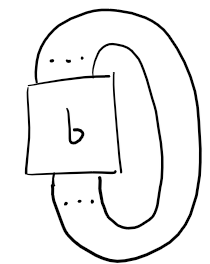If one has a $\mathbb{C}$-linear representation of the braid algebra into e.g. the Temperley-Lieb algebra i.e. $\rho:\mathbb{C}[B_{n}]\to TL_{n}(\delta)$, we can deduce a skein relation $\mathcal{S}$. Then given some diagram $D$ (for a framed link $L$) of the form
(i.e. the closure of some $n$-braid $b$) then we can apply $\mathcal{S}$ to $D$ in order to obtain some (multivariate) Laurent polynomial $f$.
It is clear that $f$ is invariant under braid isotopy on $b$. The skein relation for e.g. the Kauffman bracket can be found by considering the appropriate $\rho$.
Question: Is the above enough to claim that $\mathcal{S}$ defines a framed link invariant (i.e. that $f$ is an invariant of $L$)?
I would've thought the answer to be yes (since we can use ambient isotopy to make a type-II or III Reidemeister move on $D$ locally look like a braid isotopy).

